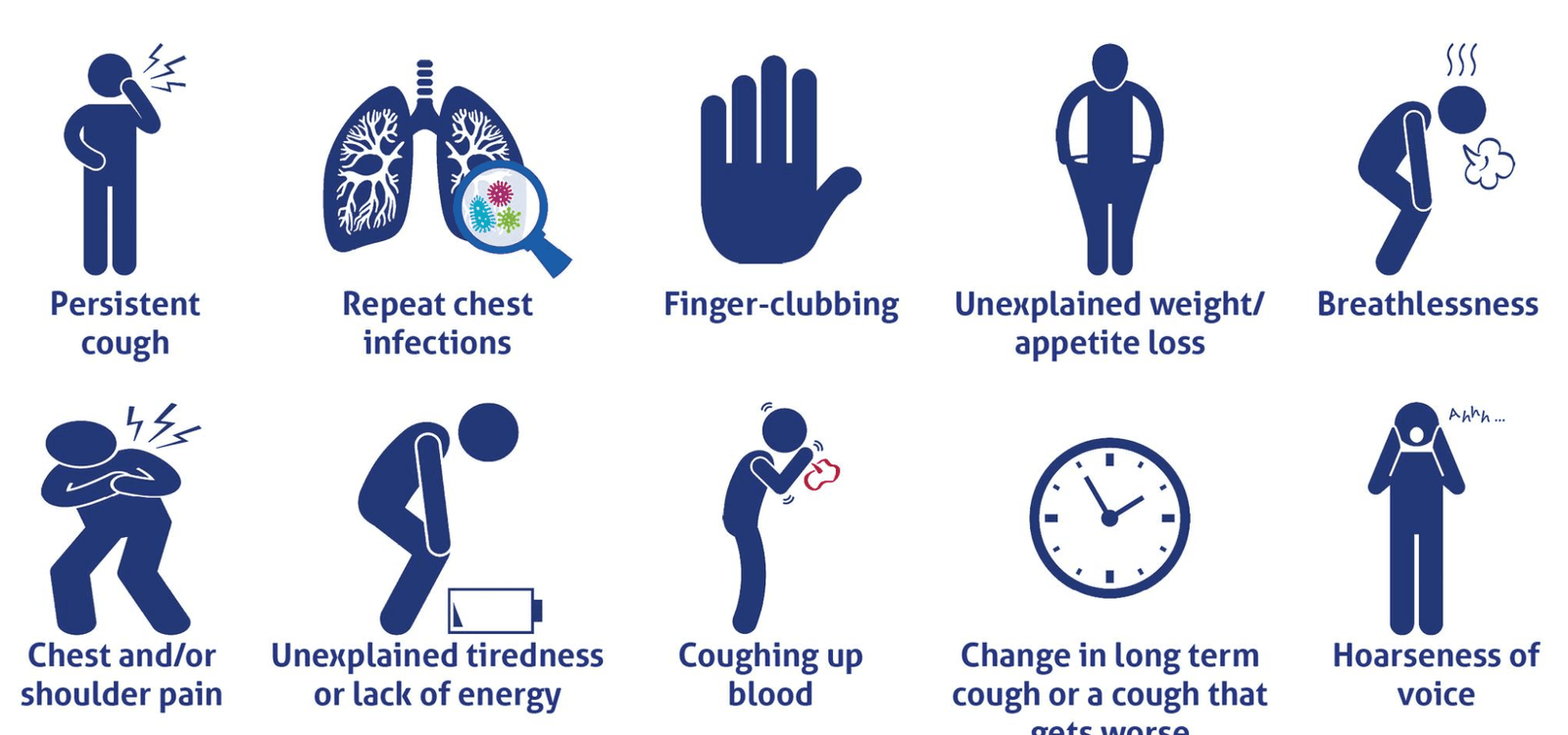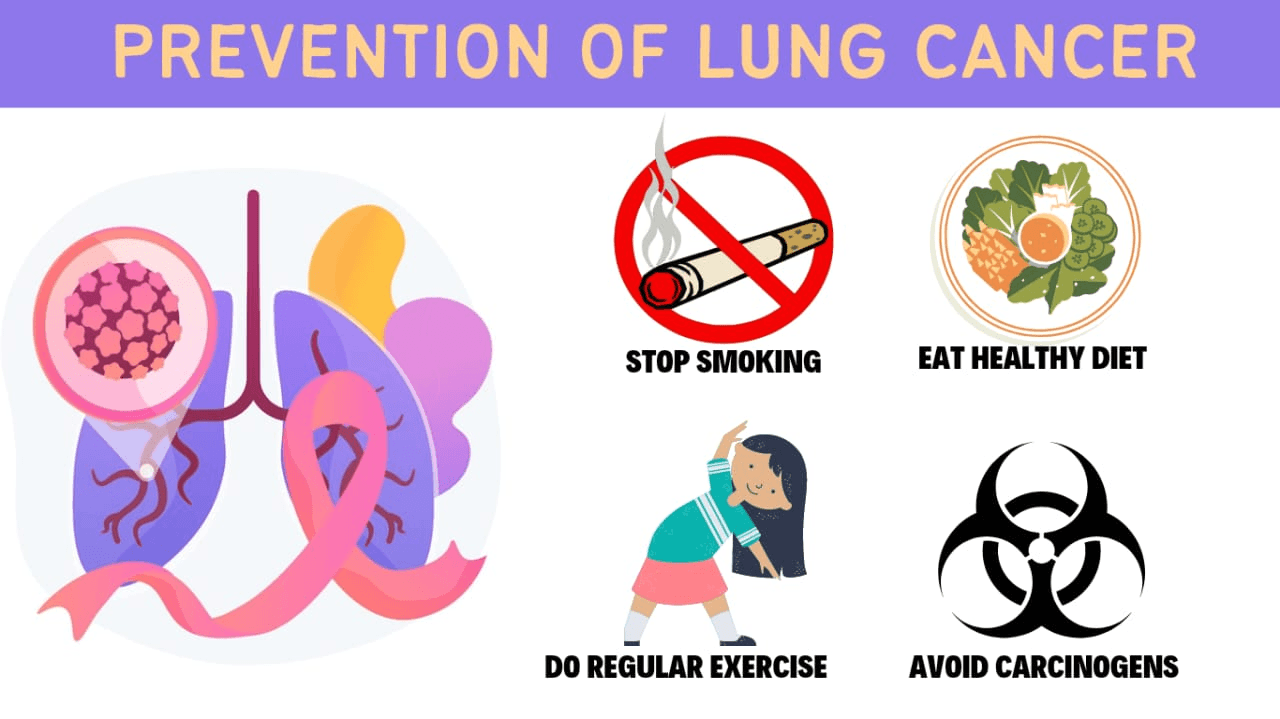Lung cancer occurred in approximately 2.2 million patients in 2020 and caused an estimated 1.8 million deaths globally. In India, lung cancer is one of the most common cancers and the leading cause of cancer deaths in men. In 2024, an estimated 81,748 new cases of lung cancer were diagnosed in India.
Lung cancer accounts for 10.5% of all cancer deaths in India. The mortality rate for lung cancer is higher in men than in women. The rising incidence and delayed diagnosis of lung cancer in India are causes for concern.
The majority of patients diagnosed with lung cancer have advanced disease at clinical presentation. This is because of the aggressive biology of the disease and the frequent absence of symptoms until locally advanced or metastatic disease is present.
Symptoms may result from local effects of the tumor or distant spread, or from distant effects not related to metastases, ie, paraneoplastic syndromes.

The Most Common Symptoms At Presentation Were Cough, Breathlessness, Chest Pain, And Weight Loss.
- Cough: new onset of cough in a person who smokes or formerly smoked should raise suspicion for lung cancer. Cough is present in approximately 75 percent of lung cancer patients at presentation and occurs most frequently in patients with squamous cell and small cell carcinomas because they tend to involve central airways. Cough productive of large volumes of thin, mucoid secretions may be a feature of mucinous adenocarcinoma. Both NSCLC and SCLC can cause post-obstructive pneumonia.
- Hemoptysis: Coughing up blood-stained sputum. Hemoptysis is reported by 15 to 30 percent of patients who are diagnosed with lung cancer. Any amount of hemoptysis can be alarming to the patient.
- Chest pain: Chest pain is present in approximately 20 to 40 percent of patients presenting with lung cancer. Pain is present on the same side of the chest as the primary tumor.
- Dyspnea: Shortness of breath is a common symptom in patients with lung cancer at the time of diagnosis, occurring in approximately 25 to 40 percent of cases.
- Wheeze may be a symptom if there is a partial obstruction of a bronchus. Stridor can result from obstruction within the trachea.
- Hoarseness: Hoarseness of voice in a smoker may be caused by laryngeal cancer or lung cancer.
- Weight loss: Unexplained weight loss without changes in diet or exercise.
- Fatigue: Feeling more tired than usual.
- Loss of appetite: Reduced desire to eat
Other symptoms can be a manifestation of superior vena cava syndrome and pancoast syndrome.

Superior vena cava syndrome:
Obstruction of the superior vena cava causes symptoms that commonly include a sensation of fullness in the head and breathlessness. Physical findings include dilated neck veins and edema of the face, neck, and upper extremities. Computed tomography can often identify the cause and level of obstruction. The SVC syndrome is more common in patients with SCLC than NSCLC.Pancoast syndrome :
Lung cancers arising in the superior sulcus (upper lobe) cause a characteristic Pancoast syndrome manifested by pain (usually in the shoulder) that radiates to the arm and wrist, Horner syndrome, bony destruction, and weakness of hand muscles. The Pancoast tumor is also known as superior pulmonary sulcus tumor. Pancoast syndrome is most commonly caused by NSCLC (typically squamous cell) and only rarely by SCLC.Horner’s syndrome (a condition characterized by drooping eyelid, constricted pupil, and reduced sweating on one side of the face).
Clinical Symptoms Of Distant Spread
Lung cancer can spread to any part of the body. The most frequent sites of distant metastasis are the liver, adrenal glands, bones, and brain.
Bone metastasis from lung cancer to bone can present with pain in the back, chest, or extremity and elevated levels of serum alkaline phosphatase. Approximately 20 percent of patients with NSCLC have bone metastases on presentation.
The adrenal glands are a frequent site of metastasis. Such metastases are rarely symptomatic. Occasionally, patients with an adrenal metastasis will have localized symptoms (eg, back or abdominal pain). In rare instances, patients can present with loss of appetite, weight loss, nausea, abdominal pain, weakness, and electrolyte imbalances secondary to adrenal insufficiency if the disease is present in bilateral adrenal glands.
Symptoms from brain metastasis are headache, vomiting, visual field loss, hemiparesis, difficulty walking, cranial nerve deficit, and seizures. In patients with NSCLC, the frequency of brain metastasis is greatest with adenocarcinoma and less with squamous cell carcinoma.
Symptomatic liver metastases are uncommon early in the course of disease. Patient with liver metastases can have abdominal pain, extreme tiredness, nausea, vomiting and jaundice (yellowing of the skin and eyes)
Paraneoplastic effects can present as hypercalcemia, hyponatremia. The severity of symptoms is related to the degree of hyponatremia and the rapidity of the fall in serum sodium. Symptoms include anorexia, nausea, and vomiting.
Lung cancer is the most common cancer associated with paraneoplastic neurologic syndromes. This is typically associated with SCLC. Symptoms may stabilize with response of the underlying cancer to treatment.
Cerebral edema can occur when the onset of hyponatremia is rapid. Symptoms caused by cerebral edema may include irritability, restlessness, personality changes, confusion, coma, seizures, and respiratory arrest.
Several hematologic abnormalities are seen in patients with lung cancer.
These include the following:
- Anemia – lack of red blood cells
- Leukocytosis – A high level of white blood cells in the blood
- Thrombocytosis – high platelet count
- Eosinophilia –when body produces too many eosinophills
- Hypercoagulable disorders – condition when the blood is more likely to clot.

Hypertrophic osteoarthropathy:
Hypertrophic pulmonary osteoarthropathy (HPO) is defined by the presence of clubbing and periosteal proliferation of the tubular bones associated with lung cancer or other lung disease. Clinically it is characterized by a symmetrical, painful arthropathy and long-bone pain that usually involves the ankles, knees, wrists, and elbows. A radiograph of the long bones (ie, femur, tibia, and fibula) can be done to diagnose hypertrophic osteoarthropathy. The symptoms of HPO may resolve after tumor resection. For patients who are not operable, the usual treatment is with nonsteroidal anti-inflammatory agents, corticosteroids, or a bisphosphonate.Dermatomyositis and polymyositis:
Dermatomyositis and polymyositis manifests clinically as muscle weakness.Cushing syndrome:
Patients typically present with muscle weakness, weight gain, hypertension, hirsutism, and osteoporosis. Cushing syndrome is rare, but is most seen in patients with SCLC, large cell neuroendocrine carcinoma, or carcinoid tumors of the lung. Patients with Cushing syndrome and SCLC appear to have a worse prognosis than patients with SCLC without Cushing syndrome.How To Reduce Risk Of Lung Cancer?
Most cases of lung cancer are caused by carcinogens in tobacco smoke.
Tobacco
Cigarette smoking is associated with 13 different malignancies: cancers of the lung, oral cavity, larynx, esophagus, bladder, kidney, pancreas, stomach, cervix, colon, rectum, liver,and acute myelogenous leukemia.
Second hand smoke is an established cause of lung cancer in non smokers, indicating that there is no safe level of cigarette smoke exposure. Second hand smoking is also called as passive smoking.
Smoking cessation decreases the risk of cancer. However, former smokers remain at elevated risk of most smoking-associated cancers compared with never-smokers, even after decades of cessation. Pipes and cigars are strongly associated with lung cancer risk.
There is an upsurge in the use of e-cigarettes, particularly among youth and young adults. We donot know the long-term health effects of e-cigarettes but the vapor includes carcinogens that might increase cancer risk.

Radon
Radon is a naturally occurring chemically inert gas that is a decay product of uranium. The risk of lung cancer is increased for underground miners who are exposed to high levels of radon.

Asbestos
Asbestos exposure combined with smoking increases the risk of lung cancer. The risk increases with the duration and intensity of asbestos fiber exposure. The risk is higher for those who smoke. Usually,the cancer is diagnosed decades after the initial exposure. Asbestos exposure can also cause other cancers, including mesothelioma. All forms of asbestos can increase the risk of lung cancer.
Other occupational or environmental exposures associated with a risk of lung cancer include arsenic, chromium, nickel, and air pollution. Air pollution has been linked to lung cancer among non-smokers.

Radiation
High doses of radiation have also been associated with an increased risk of lung cancer. An increased risk has been observed in patients with breast cancer, as well as in long-term survivors of Hodgkin and non-Hodgkin lymphomas, particularly if patients continue to smoke after completing radiation therapy.

Family History
Family history increases a person’s risk of developing lung cancer. Genetic and environmental factors contribute to familial risk of lung cancer. This is because of shared genes, exposure to shared substances, or both. Researchers have identified genetic mutations that are linked to lung cancer in some families.

Lung Cancer Screening :
Most expert organizations recommend a low-dose CT scan as screening for current or former heavy smokers of at least 30 pack-years or have quit within the last 15 years. The screening can be started after the age of 50 years.
Conclusion:
Lung cancer remains a major health challenge globally and in India, with high incidence and mortality rates. Delayed diagnosis contributes to poor outcomes, as symptoms often appear in advanced stages. Common symptoms include cough, breathlessness, chest pain, and weight loss.
Lung cancer can spread to various organs, leading to severe complications. Smoking is the leading cause, but environmental factors and genetic predisposition also play roles. Prevention through smoking cessation, reducing occupational exposure, and regular screening in high-risk individuals can help lower lung cancer risk and improve early detection, leading to better treatment outcomes.

